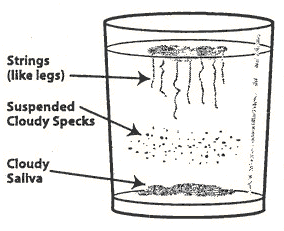Candida is a type of yeast that is found normally in small quantities in various locations of the human body. When conditions change in the body, like certain medications or some health ailments, this yeast can proliferate and produce symptoms. These symptoms vary according to where the yeast infection occurs. It is called thrush when the infection occurs in the mouth or throat. When it occurs in the genital area, it is called a yeast infection and when it occurs on a baby's diaper area, it is called diaper rash.
How to Take the Spit Test for Candida
The process of the test is as follows: spit into a glass of water as you get up in the morning. Observe how your saliva reacts in the water between 15 minutes to an hour.
 If the saliva floats on the surface of the water or mixes completely with the water, you most probably do not have a yeast infection.
If the saliva floats on the surface of the water or mixes completely with the water, you most probably do not have a yeast infection.- If the saliva floats on the surface of the water but has "strings" hanging down or if there are cloudy specks dispersed in the water or if the saliva sinks to the bottom of the water container- you have an overgrowth of candida.
The explanations for the results are:
- The Candida yeast concentrates in the saliva while the individual is sleeping, hence spitting into the water first thing in the morning. Saliva is a good medium for the proliferation of yeast–it is warm and moist.
- The yeast is denser than both water and saliva and will therefore drop to the bottom of the glass if present in the saliva.
Is Spit Test for Candida Reliable?
Although the test seems very easy to perform and the results are almost immediate, it is not a very reliable test. If you suspect you have an overgrowth of Candida yeast, either in the oral cavity, genital or elsewhere on the body, it is best to seek medical advice. An undiagnosed yeast infection can spread throughout the body and even reach the bloodstream, which can have dire consequences to your health. An uncontrolled growth of this yeast can also be indicative of other more serious health issues, which will go undiagnosed if you don't see a doctor. A medical practitioner will determine how severe the infection is and prescribe the best medication for you, depending upon your age, overall health and the severity of the infection.
Other Ways to Detect Candida Overgrowth
Apart from spit test for candida, other tests are also available to detect the overgrowth of candida.
1. Blood Tests
The test is done to detect the presence of certain antibodies. The body's immune system will produce these antibodies in high levels when there is the presence of candida overgrowth. The antibodies are specifically IgA, IgG and IgM. Another blood test that your doctor may order is the Complete Blood Count (CBC) to check for white blood cell, neutrophil and lymphocyte count.
2. Stool Analysis
The yeast overgrowth, particularly overgrowth in the colon and lower intestines, can show up in the stool. A positive result for Candida is higher than normal levels of Candida in the stool.
3. Tartaric Acid in the Urine
High levels of tartaric acid are an indication of yeast overgrowth because it is a waste product of Candida overgrowth.
You can also watch for the symptoms of the problems caused by candida overgrowth, such as oral thrush and yeast infection near the genital areas.
Common symptoms of oral thrush are:
- White spots on the tongue or on the inside of the cheeks
- Difficulty or discomfort when swallowing
- Redness in the mouth
- Broken skin at the corners of the mouth
Symptoms of a vaginal yeast infection:
- Itchiness in the vaginal region
- Redness and pain in the genital area
- Vaginal discharge that resembles "cottage-cheese"–white and clumpy
- Pain during sex
In men, there may be a rash with itchiness and pain on the tip of the penis.
What to Do If You Have Candida Overgrowth
If you find yourself being prone to Candida overgrowth after spit test for candida, or have some of the common symptoms, there are some changes you can make to minimize your risk.
1. Decrease Your Sugar Intake
Doing this will starve the yeast. Foods high in sugar and gluten create the perfect environment to allow Candida to thrive. When you cut out refined and processed foods you ensure that your body is not the ideal environment for the yeast overgrowth. Foods you should eliminate are sweets, sugars both natural (bananas and dates) and artificial, alcohol, breads, vinegar, peanuts, etc. Milk, which contains a sugar called lactose, should also be eliminated from the diet. Keep the diet high in protein and consume healthy fats like salmon and avocados.
2. Try Certain Foods
Consume foods like garlic, turmeric and coconut oil that have the ability to kill the fungus. Garlic and turmeric are well-known natural antifungals whilst coconut oil contains a compound called caprylic acid, which has anti-microbial properties that can kill yeasts. Use antifungal herbs like olive leaf, berberine and grapefruit seed extract.
3. Take Probiotics
These help replenish the body with good bacteria that helps with controlling digestion, improving the immune system and maintaining a healthy balance of good intestinal bacteria, thus eliminating the Candida overgrowth. Probiotics are available commercially in health stores. Certain fermented foods are also high-probiotic: yoghurt, kefir, kombucha, sauerkraut and coconut water all contain healthy bacteria and help eliminate Candida.
4. Detoxification
Detox the body using milk thistle to ensure the liver is functioning at optimal level. A well-functioning liver can help eliminate the candida overgrowth. Candida overgrowth has also been shown to impair liver function.
